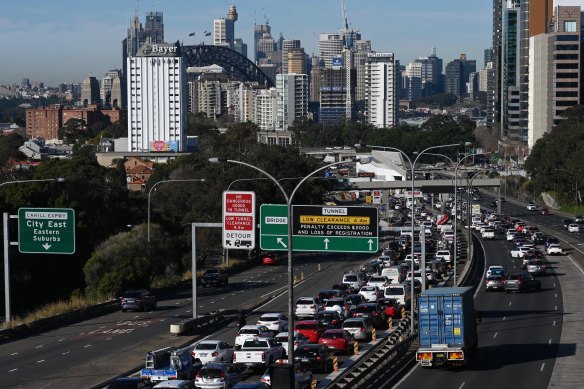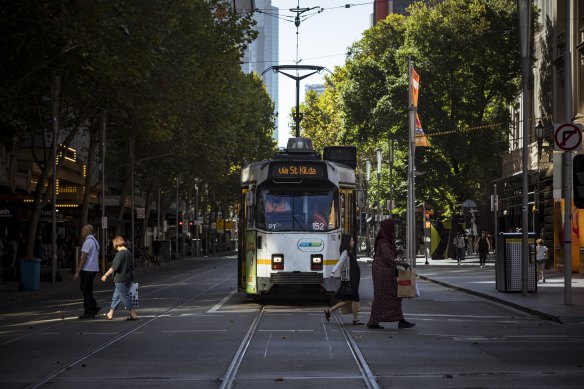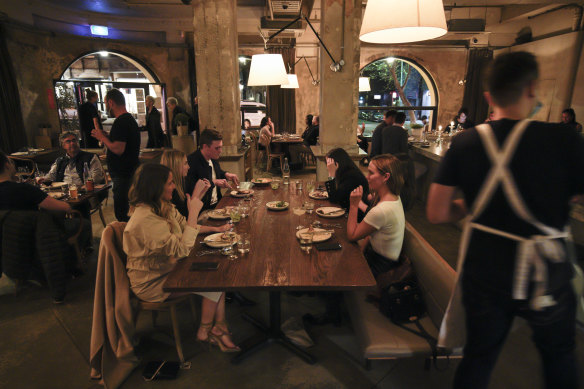- Analysis
- National
- Coronavirus pandemic
This was published 4 years ago
Why Melbourne? The answer to lockdowns doesn’t lie in demographic differences to Sydney
It’s an understandable question for Melburnians enduring their fourth lockdown: why us? What is it that seems to have made the Victorian capital more susceptible than its sister city, Sydney, when it comes to the spread of COVID-19?
It might be the wrong question to ask because, with the exception of Melbourne’s second wave last winter, outbreaks in both cities have looked fairly similar. Sydney experienced the Crossroads Hotel, Thai Rock, Avalon and Berala clusters. The difference was in the response: the NSW government has a much higher threshold for restrictions, especially lockdowns, than Victoria.

Commentators have raised the theory that Sydney’s congestion leads people to stick to their localities within the city.Credit: Nick Moir
Based on previous experience, if Victoria’s current outbreak were in Sydney, it’s unlikely the city would be in lockdown. If Daniel Andrews had been managing the Avalon outbreak, it’s likely a city-wide lockdown would have occurred.
But let’s entertain the idea that there is something special about Melbourne. There was conjecture its weather might play a role and, although some studies have suggested the virus spreads more easily in winter, the jury is still out about the extent to which that is a factor.
Last week, as Melbourne’s lockdown was extended for a second week, some commentators raised another hypothesis: that Sydney and Melbourne were different in their demography, geography, use of public transport and level of mixing between people from different areas.
University of NSW epidemiologist Marylouise McLaws, a Sydneysider, said on ABC television on Monday afternoon that Melbourne had better public transport and younger residents.
“People [in Melbourne] can get around really easily or walk or [on a] push bike. We can’t do that in Sydney,” she said. “You’re hyper-connected socially. Your city has younger people than Sydney has and they like to go out. Or they’re unemployed and they need jobs. It’s the young and it’s that sociability and it’s the ease with which people can get around Melbourne.”
This was picked up by Melbourne-based federal Labor frontbencher Clare O’Neil, again on ABC television, on Wednesday morning.
“They [epidemiologists] have referred to a bunch of specific things about Victoria – the layout of the city, for example, is one where people move around a lot more than they do versus Sydney, for example, where people tend to stay within their suburbs or their regions,” she said. Fiona Patten, Victoria’s Reason Party leader, also cited this theory in a tweet.
The notion that structural differences in the make-up, layout and behavioural patterns of the two cities has also proved seductive on social media and speaks to prevailing stereotypes about Sydney and Melbourne. But it does not stand up to scrutiny.
The Australian Bureau of Statistics instantly disproves the assertion that Melbourne’s population is younger – at the last census in 2016, the median age in both cities was 36.

Marylouise McClaws said town planners had told her it was desirable to socialise across different areas of Melbourne.Credit: Chris Hopkins
And whatever opinions one might hold about public transport in Opal-land or Myki-ville, the evidence shows more people use it in Sydney than Melbourne.
At the same census Sydneysiders reported significantly higher use of public transport to get to work each day – 27 per cent, compared to 19 per cent of Melburnians. There was essentially no difference in the average length of commutes: 16.5 kilometres in Sydney versus 16.8 kilometres in Melbourne.
McLaws later told 9News the actual difference was that in Sydney people used public transport to go to work and back, while in Melbourne they also used it to go to “special little areas in the CBD” such as bars, restaurants and ice-cream parlours. She also clarified that when she said Melbourne had younger people, she was referring to the population of its CBD, which has a high proportion of people aged 20 to 39.
The contention that Sydneysiders are less inclined to leave their locality, such as the inner west or north shore, is a bit more difficult to evaluate. It certainly has some anecdotal support: we all know people who don’t like crossing the Harbour Bridge (or the Yarra, for that matter). And the peculiar geography of the northern beaches, with three arterial roads in and out, meant it could be locked down during the Avalon outbreak in a way that would be harder in Melbourne.
McLaws told The Sun-Herald and The Sunday Age her assertion was not based on hard data but advice from town planners that in Melbourne “it’s very desirable to socialise in lots of different areas”, while in Sydney “you’ve got to travel quite some distance”.
“The data are not granular enough to really get into it,” she said. “I’m just suggesting that there’s a sociability factor that may be more difficult to find. There is something going on and it’s not for blame; it’s understanding that the disease does not just use humans, it uses human behaviours.”
The ABS has some basic data on travel patterns around our cities. It measures “self-containment”, or how many people work in the same statistical area as they live. Sydney had the lowest level of self-containment of any capital city: 43.4 per cent worked in the same area as they lived, versus 51. 8 per cent in Melbourne. While that doesn’t account for social travel, it is at least an indication.
At various times it has also been asserted that Melbourne’s density eclipses Sydney and that this may impact its susceptibility to the virus’ spread. It’s certainly true that Melbourne is growing faster: its population is expected to overtake Sydney this decade (and probably already has, depending on how you calculate it). But density is different story.
At the 2016 census, the population of the Sydney significant urban area was 4,446,805 and it was 4196 square kilometres. This includes the Blue Mountains up to Katoomba, but not the Central Coast or Picton, which form part of Greater Sydney. The population of the Melbourne SUA was 4,323,072 and it was 6189 square kilometres – so Sydney metro is significantly denser.

The contention that Sydneysiders are less inclined than people from Melbourne to leave their locality is difficult to evaluate.Credit: Wolter Peeters
It’s true Melbourne’s CBD is the densest place in Australia, followed by the Sydney locales of Potts Point-Woolloomooloo and Pyrmont-Ultimo. But there’s another way to slice the data.
The ABS divides the country into grid cells of 1 square kilometre. In Sydney, 193 cells were “high” density (5000 to 8000 people per square kilometre) or “very high” density (more than 8000 people) – much more than Melbourne (77) or Brisbane (15).
Liz Allen, a demographer at the Australian National University (in the neutral city of Canberra), collated much of this data into a popular thread on Twitter last week. Asked if there was a grain of truth to any of the assertions about differences between the two cities, she said no.
“There’s really no discernable difference between Victoria and NSW or Melbourne and Sydney when we look at these key demographic characteristics,” she said. “These conflicts are as old as the towns themselves. What makes the myth so effective is that it does sit with our stereotypes and it does trigger emotion.”
McLaws also raised migrant demographics as an issue, telling the ABC that Melbourne had a “very well-connected migrant group”.
“You know what it’s like being a first generation migrant group – they live together and they support each other, and that can be a downfall as well for spread.”
At the last census, 42.9 per cent of people in Greater Sydney said they were born overseas and 49.4 per cent said both parents were born overseas. In Greater Melbourne, those figures were 40.2 per cent and 46.2 per cent respectively.
Allen said in any case it was wrong and unhelpful to focus on migrants or demographics when systemic factors such as the public health system – or plain luck – were more likely involved.
“It’s much easier to point the finger at people ... ‘it’s the young, it’s the migrants, it’s the poor’,” she said. “And within that there are value judgments around what is suitable behaviour. These myths go directly to the heart of prejudice and in doing so we’re actually turning on ourselves.”
Stay across the most crucial developments related to the pandemic with the Coronavirus Update. Sign up to receive the weekly newsletter.